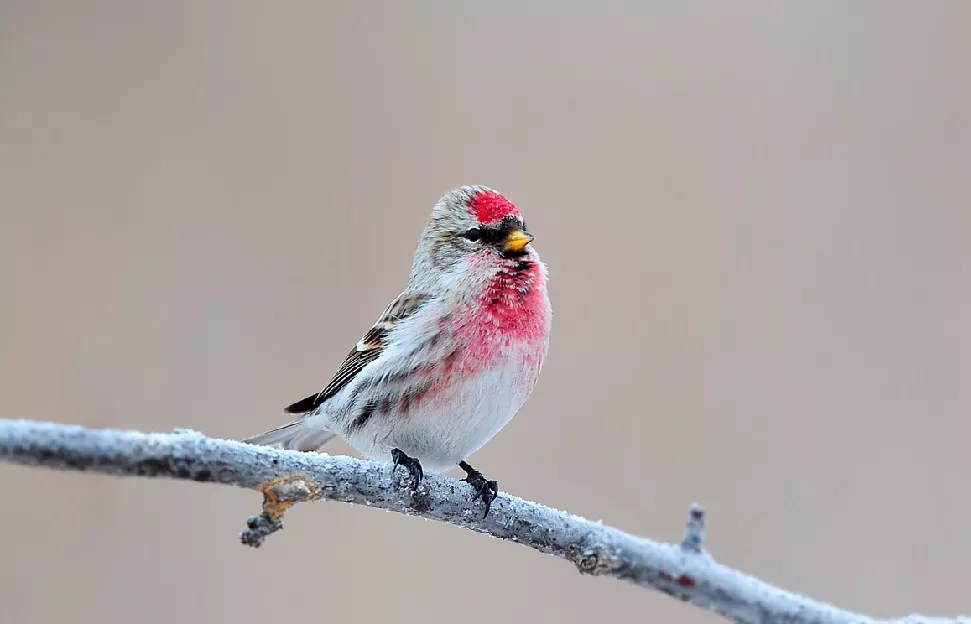The Common Redpoll (Acanthis flammea) is a small passerine bird belonging to the finch family, Fringillidae. With its vibrant red cap and subtle yet charming appearance, this species is a common sight across its range in the northern hemisphere. It breeds somewhat further south than the Arctic redpoll, also in habitats with thickets or shrubs. In this article, we delve into various aspects of the Common Redpoll, including its physical description, habitat and range, behavior, diet and more.
Physical Description
The Common Redpoll is a diminutive bird, measuring around 11 to 14 centimeters in length, with a wingspan of approximately 18 to 22 centimeters. Its plumage is primarily brown and streaked, providing excellent camouflage in its natural habitat. One of its most distinctive features is the crimson-colored cap atop its head, which contrasts beautifully with the rest of its plumage.
Sexual dimorphism is minimal in Common Redpolls, with males and females displaying similar plumage patterns. However, during the breeding season, males may exhibit slightly brighter colors and more pronounced red caps compared to females.
Habitat and Range
Common Redpolls are found in a variety of habitats across the northern regions of North America, Europe, and Asia. They typically inhabit open woodlands, shrublands, and areas with abundant birch and alder trees. During the breeding season, they prefer to nest in coniferous forests or scrublands, where they can find ample cover and nesting sites.
These birds are also known for their migratory behavior, with populations in the northernmost regions undertaking seasonal migrations to more temperate areas during the winter months. Their range extends from the Arctic tundra to as far south as the northern United States, Europe, and Asia.
Behavior and Diet
Common Redpolls are highly social birds, often forming flocks during the non-breeding season. They exhibit a variety of typical finch behaviors, including acrobatic flight and vocalizations such as chirps and trills. When foraging, they are primarily seed-eaters, with a particular fondness for birch and alder seeds. They may also consume buds, berries, and insects, especially during the breeding season when protein-rich food sources are essential for raising their young.
Foraging behavior varies depending on the season and food availability. During the winter months, Common Redpolls may visit backyard feeders in search of supplementary food sources, providing bird enthusiasts with excellent opportunities for observation.
Breeding and Nesting
Breeding season for Common Redpolls typically occurs in the spring and summer months, coinciding with the abundance of food resources. They construct cup-shaped nests made of twigs, grasses, and lichens, often concealed within dense vegetation for protection against predators.
Female Common Redpolls lay a clutch of 4 to 6 pale blue eggs speckled with darker markings. Both parents take turns incubating the eggs for approximately two weeks until they hatch. After hatching, the chicks are fed a diet of regurgitated food by both parents until they are ready to fledge, usually around two weeks after hatching.
Conservation Status
The conservation status of the Common Redpoll is currently of least concern according to the International Union for Conservation of Nature (IUCN). However, like many bird species, Common Redpolls face various threats to their population, including habitat loss, predation by introduced species, and climate change. Conservation efforts focus on habitat preservation and monitoring population trends to ensure the long-term survival of this species.
Conclusion
The Common Redpoll, with its charming appearance and lively behavior, captivates bird enthusiasts and casual observers alike across its range in the northern hemisphere. From its distinctive red cap to its social foraging habits, this species embodies the resilience and adaptability of birds in diverse ecosystems. By understanding its habitat preferences, behavior, and conservation needs, we can ensure the continued survival and enjoyment of the Common Redpoll for generations to come.
Related Topics:
- Common Redpoll vs Lesser Redpoll: What’s the Difference?
- Common Redpoll vs House Finch: What is the Difference?
- Arctic Redpoll vs Common Redpoll: What’s the Difference?



 Facebook
Facebook  Instagram
Instagram  Youtube
Youtube 